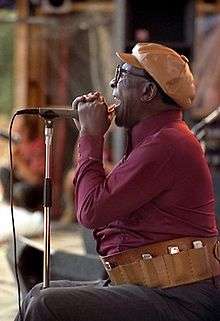Sonny Terry
| Sonny Terry | |
|---|---|
 Terry performing at Nambassa in 1981 | |
| Background information | |
| Birth name | Saunders Terrell |
| Born |
24 October 1911 Greensboro, Georgia, United States |
| Origin | North Carolina, United States |
| Died |
11 March 1986 (aged 74) Mineola, New York |
| Genres | Harmonica blues, Piedmont blues,[1] country blues, blues revival, folk-blues, East Coast blues |
| Occupation(s) | musician |
| Instruments | Vocals, harmonica, jaw harp |
| Years active | 1930s–1980s |
| Labels | Atlantic, ABC |
| Associated acts | Brownie McGhee, Sonny Terry and His Night Owls |
Saunders Teddell,[2][3] or Saunders Terrell (or other variants, sources differ) (October 24, 1911 – March 11, 1986),[4] known as Sonny Terry, was an American Piedmont blues and folk musician,[1] who was known for his energetic blues harmonica style, which frequently included vocal whoops and hollers and occasionally imitations of trains and fox hunts.
Career
Terry was born in Greensboro, Georgia.[5] His father, a farmer, taught him to play basic blues harp as a youth. He sustained injuries to his eyes and went blind by the time he was 16, which prevented him from doing farm work,[4] and was forced to play music in order to earn a living. Terry played Campdown Races to the plow horses which improved the efficiency of farming in the area. He began playing blues in Shelby, North Carolina. After his father died, he began playing in the trio of Piedmont blues–style guitarist Blind Boy Fuller. When Fuller died in 1941, Terry established a long-standing musical relationship with Brownie McGhee, and they recorded numerous songs together. The duo became well known among white audiences during the folk music revival of the 1950s and 1960s. This included collaborations with Styve Homnick, Woody Guthrie and Moses Asch, producing classic recordings for Folkways Records (now Smithsonian/Folkways).
In 1938 Terry was invited to play at Carnegie Hall for the first From Spirituals to Swing concert,[4] and later that year he recorded for the Library of Congress. He recorded his first commercial sides In 1940. Some of his most famous works include "Old Jabo", a song about a man bitten by a snake, and "Lost John", which demonstrates his amazing breath control.
Despite their fame as "pure" folk artists, in the 1940s Terry and McGhee fronted a jump blues combo with honking saxophone and rolling piano, which was variously billed as Brownie McGhee and his Jook House Rockers or Sonny Terry and his Buckshot Five.
Terry was also in the 1947 original cast of the Broadway musical comedy Finian's Rainbow.[6] He also appeared in the film The Color Purple, directed by Steven Spielberg. With McGhee, he appeared in the 1979 Steve Martin comedy The Jerk. Terry collaborated with Ry Cooder on "Walkin' Away Blues". He also performed a cover of Robert Johnson's "Crossroad Blues" for the 1986 film Crossroads.
Terry died of natural causes in Mineola, New York in March 1986, three days before Crossroads was released in theaters.[7] He was inducted into the Blues Hall of Fame in the same year.[4]
Discography
- Sonny Terry's Washboard Band (Folkways, 1955)
- Folk Songs of Sonny Terry and Brownie McGhee (Roulette, 1958)
- Blues with Big Bill Broonzy, Sonny Terry and Brownie McGhee (Folkways, 1959)
- Brownie McGhee, Sonny Terry at The Bunkhouse (Smash, 1965)[8]
- Sonny's Story (Bluesville, 1960)
- Sonny Is King (Bluesville, 1960)
- Sing & Play (Society, 1966)
- Sonny Terry's New Sound: The Jawharp in Blues and Folk Music, with Brownie McGhee & J.C. Burris (Folkways, 1968)
- Sonny & Brownie (A&M Records, 1973)
- Robbin' the Grave (Blue Labor, 1974)
- Whoopin', with Johnny Winter and Willie Dixon (Alligator, 1984)
- Brownie McGhee and Sonny Terry Sing (Smithsonian Folkways, 1990)
- Whoopin' the Blues: The Capitol Recordings, 1947–1950 (Capitol, 1995)
See also
References
- 1 2 Du Noyer, Paul (2003). The Illustrated Encyclopedia of Music. Fulham, London: Flame Tree Publishing. p. 181. ISBN 1-904041-96-5.
- ↑ Herzhaft, Gérard (1992). Encyclopedia of the Blues. University of Arkansas Press. p. 227. ISBN 978-1-55728-252-1.
- ↑ Clarke, Joseph F. (1977). Pseudonyms. BCA. p. 159.
- 1 2 3 4 Campbell, Al. "Sonny Terry: Biography". AllMusic.com. Retrieved 2015-10-07.
- ↑ Terry, Sonny (as told to Kent Cooper) (1975). The Harp Styles of Sonny Terry. Oak Publications. p. 7. Other sources give his place of birth as Greensboro, North Carolina.
- ↑ Russell, Tony (1997). The Blues: From Robert Johnson to Robert Cray. Dubai: Carlton Books. pp. 62–63. ISBN 1-85868-255-X.
- ↑ Doc Rock. "The 1980s". TheDeadRockStarsClub.com. Retrieved 2015-10-07.
- ↑ "Sonny Terry & Brownie McGhee, At the Bunkhouse: Songs, Reviews, Credits". AllMusic.com. Retrieved 2015-10-07.